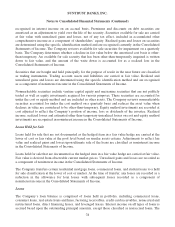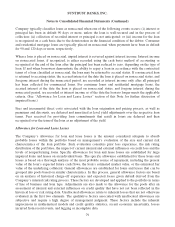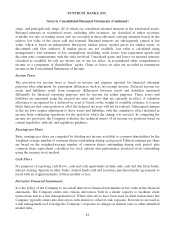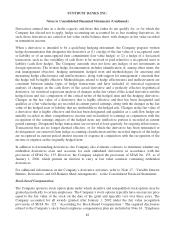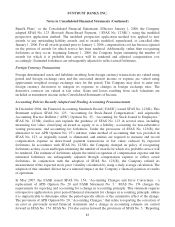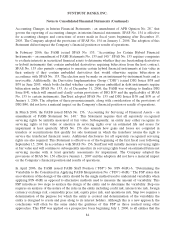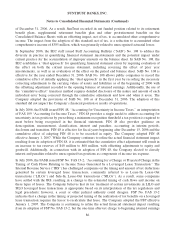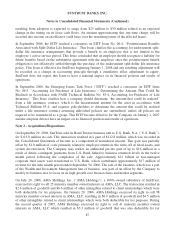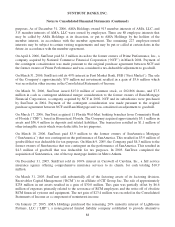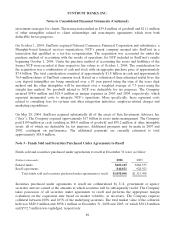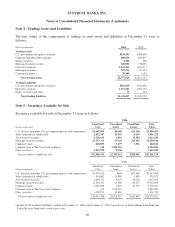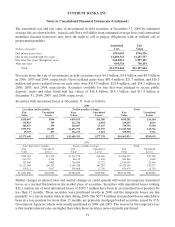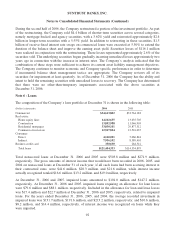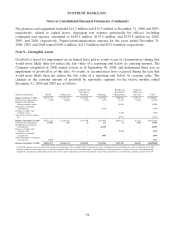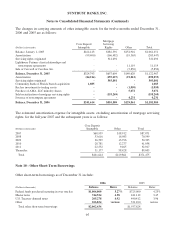SunTrust 2006 Annual Report Download - page 99
Download and view the complete annual report
Please find page 99 of the 2006 SunTrust annual report below. You can navigate through the pages in the report by either clicking on the pages listed below, or by using the keyword search tool below to find specific information within the annual report.SUNTRUST BANKS, INC.
Notes to Consolidated Financial Statements (Continued)
of December 31, 2006. As a result, SunTrust recorded its net funded position related to its retirement
benefit plans, supplemental retirement benefits plan and other postretirement benefits on the
Consolidated Balance Sheets with an offsetting impact, net of tax, to accumulated other comprehensive
income. The impact from the adoption of this standard, net of tax, is a reduction to accumulated other
comprehensive income of $385 million, which was primarily related to unrecognized actuarial losses.
In September 2006, the SEC staff issued Staff Accounting Bulletin (“SAB”) No. 108 to address the
diversity in practice in quantifying financial statement misstatements and the potential impact under
current practice for the accumulation of improper amounts on the balance sheet. In SAB No. 108, the
SEC establishes a “dual approach” for quantifying financial statement errors by requiring evaluation of
the effect on both the current income statement, including reversing the effect of prior year
misstatements, as well as an evaluation of the effect on the period end balance sheet. SAB No. 108 is
effective for the year ended December 31, 2006. SAB No. 108 allows public companies to record the
cumulative effect of initially applying the “dual approach” in the first year by recording the necessary
correcting adjustments to the carrying values of assets and liabilities as of the beginning of 2006 with
the offsetting adjustment recorded to the opening balance of retained earnings. Additionally, the use of
the “cumulative effect” transition method requires detailed disclosure of the nature and amount of each
individual error being corrected through the cumulative adjustment and how and when it arose. The
Company adopted the provisions of SAB No. 108 as of December 31, 2006. The adoption of this
standard did not impact the Company’s financial position or results of operations.
In July 2006, the FASB issued FIN 48, “Accounting for Uncertainty in Income Taxes,” an interpretation
of FAS 109 “Accounting for Income Taxes.” FIN 48 provides a single model to address accounting for
uncertainty in tax positions by prescribing a minimum recognition threshold a tax position is required to
meet before being recognized in the financial statements. FIN 48 also provides guidance on
derecognition, measurement, classification, interest and penalties, accounting in interim periods,
disclosure and transition. FIN 48 is effective for fiscal years beginning after December 15, 2006 and the
cumulative effect of adopting FIN 48 is to be recorded in equity. The Company adopted FIN 48
effective January 1, 2007. While the Company continues to refine the actual financial statement impact
resulting from its adoption of FIN 48, it is estimated that the cumulative effect adjustment will result in
an increase to tax reserves of $40 million to $60 million, with offsetting adjustments to equity and
goodwill. Additionally, in connection with its adoption of FIN 48, the Company elected to classify
interest and penalties related to unrecognized tax positions as components of income tax expense.
In July 2006, the FASB issued FSP No. FAS 13-2, “Accounting for a Change or Projected Change in the
Timing of Cash Flows Relating to Income Taxes Generated by a Leveraged Lease Transaction.” The
Internal Revenue Service (“IRS”) has challenged companies on the timing and amount of tax deductions
generated by certain leveraged lease transactions, commonly referred to as Lease-In, Lease-Out
transactions (“LILOs”) and Sale-In, Lease-Out transactions (“SILOs”). As a result, some companies
have settled with the IRS, resulting in a change to the estimated timing of cash flows and income on
these types of leases. The Company believes that its tax treatment of certain investments in LILO and
SILO leveraged lease transactions is appropriate based on its interpretation of the tax regulations and
legal precedents; however, a court or other judicial authority could disagree. FSP No. FAS 13-2
indicates that a change in the timing or projected timing of the realization of tax benefits on a leveraged
lease transaction requires the lessor to recalculate that lease. The Company adopted the FSP effective
January 1, 2007. The Company is continuing to refine the actual financial statement impact resulting
from its adoption of FSP No. FAS 13-2, but the one-time after-tax charge to beginning retained earnings
86




